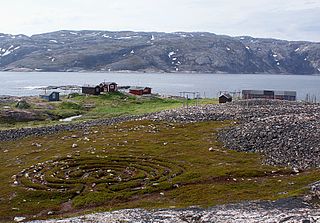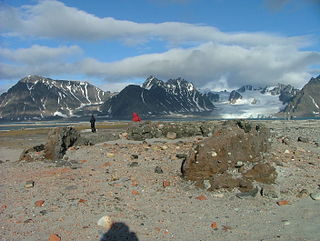
Svalbard, also known as Spitsbergen or Spitzbergen, is a Norwegian archipelago in the Arctic Ocean. North of mainland Europe, it lies about midway between the northern coast of Norway and the North Pole. The islands of the group range from 74° to 81° north latitude, and from 10° to 35° east longitude. The largest island is Spitsbergen, followed in size by Nordaustlandet and Edgeøya. The largest settlement is Longyearbyen on the west coast of Spitsbergen.

Spitsbergen is the largest and the only permanently populated island of the Svalbard archipelago in northern Norway.
.no is the Internet country code top-level domain (ccTLD) for Norway. Norid, the domain name registry, is based in Trondheim, is owned by the state-owned Uninett and operates under supervision of the Norwegian Communications Authority. As of December 24, 2022 there were 843,749 registered .no domains. Organizations with a presence in Norway and registration at the Brønnøysund Register Centre are limited to 100 domains each. Individuals residing in Norway may register in the second-level domain priv.no and, as of June 17, 2014, directly under .no. Other second-level domains exist for organizations of certain types, such as municipalities and schools. The strict regulations have resulted in near-absence of cybersquatting and warehousing.

The Norwegian Polar Institute is Norway's central governmental institution for scientific research, mapping and environmental monitoring in the Arctic and the Antarctic. The NPI is a directorate under Norway's Ministry of Climate and Environment. The institute advises Norwegian authorities on matters concerning polar environmental management and is the official environmental management body for Norwegian activities in Antarctica.

Holmengrå is the name a small fishing village in Sør-Varanger Municipality in Troms og Finnmark county, Norway. The village lies on a small area of flat land along the Holmengråfjorden. The 265-metre (869 ft) tall mountain Holmengråfjellet lies just west of the village. The area is rocky with poor boat access. There is some grass and heather around the village, but the ground is mostly rocks.

Svalbard lies under the sovereignty of Norway, but the Svalbard Treaty places several restrictions. Norway cannot use the archipelago for warlike purposes, cannot discriminate economic activity based on nationality and is required to conserve the natural environment. Uniquely, Svalbard is an entirely visa-free zone. Everybody may live and work in Svalbard indefinitely regardless of country of citizenship. Svalbard Treaty grants treaty nationals equal right of abode as Norwegian nationals. Non-treaty nationals may live and work indefinitely visa-free as well. "Regulations concerning rejection and expulsion from Svalbard" is in force on non-discriminatory basis.
The Royal Norwegian Ministry of Climate and Environment is a Norwegian ministry established on 8 May 1972. The Ministry of Climate and Environment has a particular responsibility for carrying out the climate and environmental policies of the Government. Before 2014 the name was Ministry of the Environment.

The Norwegian Police Service is the Norwegian national civilian police agency. The service dates to the 13th century when the first sheriffs were appointed, and the current structure established in 2003. It comprises a central National Police Directorate, seven specialty agencies and twelve police districts. The government agency is subordinate to the Ministry of Justice and Public Security and has 16,000 employees, of which 8,000 are police officers. In addition to police powers, the service is responsible for border control, certain civil duties, coordinating search and rescue operations, counterterrorism, highway patrolling, writ of execution, criminal investigation and prosecution. The directorate is led by National Police Commissioner Odd Reidar Humlegård.
The Government agencies of Norway are state controlled organizations that act independently to carry out the policies of the Government of Norway. The Government Ministries are relatively small and merely policy-making organizations, allowed to control agencies by policy decisions but not by direct orders. A Minister is explicitly prohibited from interfering with the day-to-day operation in an agency or the outcome in individual cases. While no minister is allowed to give orders to agencies personally, they are subject to decisions made by the Government. Also, the Minister is normally the instance of appeals of agencies decisions.

The Sámi Parliament of Norway is the representative body for people of Sámi heritage in Norway. It acts as an institution of cultural autonomy for the Sami people of Norway.

The Norwegian Year of Cultural Heritage 2009 or Kulturminneåret 2009 was aimed at highlighting the diversity and importance of Norway's cultural heritage for all sectors of the community. Under the theme of Cultural Heritage in Everyday Life, the arrangements were intended to involve both ordinary citizens and professionals at local, regional and national levels.

The Ministry of Transportation, formerly Department of Transportation is a government ministry responsible for the governance and regulation of transportation in Indonesia. The Ministry is located in Jakarta.
The Ministry of Culture is a government ministry office of the Syrian Arab Republic, responsible for cultural affairs in Syria.
Norway's elongated shape, its numerous internal geographical barriers, and the often widely dispersed and separated settlements are all factors that have strongly influenced the structure of the country's administrative subdivisions. This structure has varied over time and is subject to continuous review. In 2017 the government decided to abolish some of the counties and to merge them with other counties to form larger ones, reducing the number of counties from 19 to 11, which was implemented on 1 January 2020.

MS Nordstjernen is a vessel constructed in Hamburg, Germany in 1956, and used on the Hurtigruten coastal service until 2012. It was the oldest operational ship in the Hurtigruten fleet at the time of its withdrawal, and is the ship with the longest history of Hurtigruten service. In 2012, she was protected as a national heritage in Norway.

Indre Wijdefjorden National Park is located in a steep fjord landscape in northern Spitsbergen in Svalbard, Norway. It covers the inner part of Wijdefjorden—the longest fjord on Svalbard. The national park was established on 9 September 2005 and covers 1,127 km2 (435 sq mi), of which 745 km2 (288 sq mi) is on land and 382 km2 (147 sq mi) is sea. The marine environment changes vastly from the mouth of the fjord, through a still, cold, water basin, becoming deeper before reaching the glacier Mittag-Lefflerbreen at the inner-most sections of the fjord.

The archaeology of Svalbard is the study of human activity in the northerly Arctic Ocean archipelago's past. The geography, environment and climate of Svalbard have resulted in exceptional preservation conditions. Archaeological fieldwork on Svalbard is both expensive and physically exhausting, but new technology and infrastructure has allowed easier access. This easier access has also resulted in more damage caused by tourists.

The National Protection Plan for Roads, Bridges, and Road-Related Cultural Heritage was published by the Norwegian Public Roads Administration in 2002 in the volume Vegvalg. The plan contains road heritage in Norway dating from 1537 to 1999 that has been owned or used by the state. In addition to roads and bridges, some of the Public Roads Administration's own machinery, equipment, and buildings are included in the plan. However, no ferries are included in the plan, and streets, boulevards, stepping stones, and winter roads are not systematically registered.
The Cultural Heritage Act of 1978 is a Norwegian law that protects heritage sites and cultural environments. The structures and spaces that it covers are deemed to have cultural or architectural value. The act includes heritage such as structures and sites, sometimes the area around a monument, protected structures, boats, shipwrecks, and cultural environments. The act describes what automatically enjoys cultural heritage protection and what may be protected under an individual decision.















